-
超导机理
实验室 Laboratory for
the mechanism
of superconductivity -
We focus on unconventional superconductors,
to clarify emergent complex physical properties
in strongly correlated electron systems.
We utilize atomically accurate thin film synthesis techniques to rationally construct new superconducting material structures and heterointerfaces. In addition to low-temperature high-field mesoscopic physical property measurements, we perform in situ high-resolution angle-resolved photoemission spectroscopy (ARPES) experiments to gain insights into the electronic structures in order to unravel the microscopic mechanism underlying the macroscopic phenomena. We target to further increase the superconducting transition temperature as well as to create new superconducting quantum devices.
We devote to experimental technology innovations for scientific research. We promote the oxidation strength of the oxide molecular beam epitaxy system, enabling the growth of superconducting thin films that are previously unaccessible. We are working to improve the time resolution of time-resolved angle-resolved photoelectron spectroscopy for the direct detection of electron-phonon coupling. We develope a series of quasi-in situ electrical, magnetic, and thermal measurement techniques for mesocopic physical properties.
Superconductor
Tool Development
Superconductor
Superconductivity is a phenomenon that a material loses electrical resistance and becomes perfectly diamagnetic below a certain temperature, known as the superconducting transition temperature (TC), first discovered in mercury in 1911. Zero resistance means that current can flow unobstructed without energy loss. The perfect diamagnetism of superconductors in weak magnetic fields is called the Meissner effect. Supercondutors hold great promise for applications, but the TC of conventional superconductors (e.g. metals and alloys) is capped below 40 K by known physical priciples (i.e. Bardeen-Cooper-Schrieffer theory), so the refrigeration to achieve superconductivity is costly.
High-temperature superconductors (HTS), with their TC and lower refrigeration cost, have great prospects for development in a wide range of industries such as electric power, electronic information, transportation, medical care and emerging quantum technologies, and may trigger a new round of technological revolution in the next two decades. However, the microscopic mechanism of HTS has not been understood so far, which has become a major obstacle to the progress of HTS technology. In HTS materials, the charge and spin interactions between electrons, the coupling between electrons and phonons, and exotic quantum phase fluctuations, may be intertwined to exhibit remarkable and peculiar manifestations, leading to abundant quantum phases and simultaneously bringing great challenges to understand due to the complexity of the many-body problem. Understanding the microscopic mechanism is the prerequisite for the in-depth development of HTS.
For more than 30 years since the discovery of cuprates in 1986, new physical phenomena around the superconducting phase have been discovered continuously, but the basic superconducting pairing mechanism is still debated. Theories that unite human wisdom collide with each other, making it difficult to reach a consensus. The key reason is the lack of concise and concrete experimental evidence. Cuprate superconductors have complex crystal structures and electronic structures, within which various electronic and lattice factors interplay on similar energy scales. It is difficult to grasp the dominating factor that leads to superconducting pairing in such a complex physical phenomenon. Therefore, the key to solving the problem of HTS mechanism is how to simplify the phenomena experimentally.
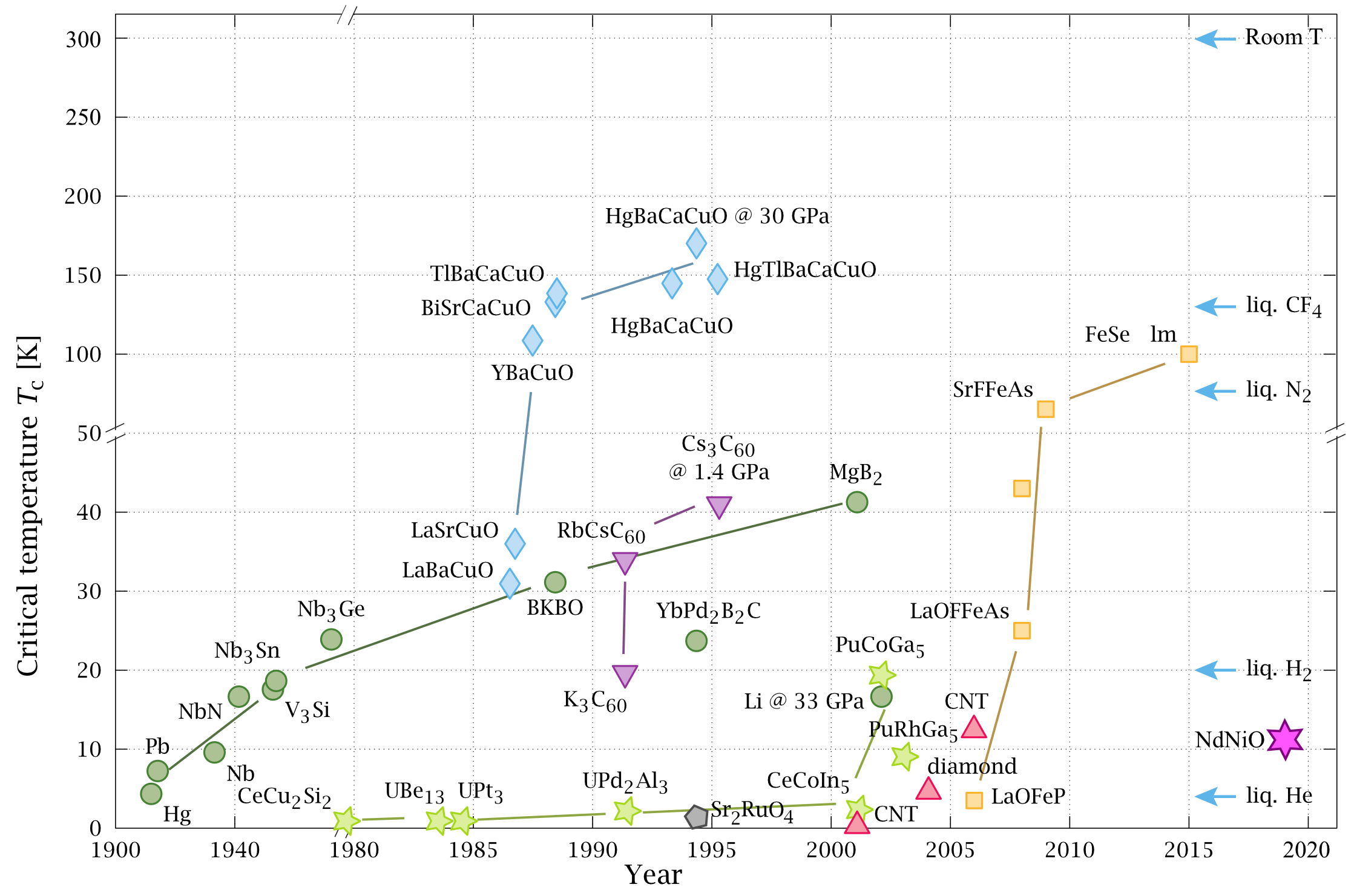
Figure: History of the discovery of superconductors [source: wikipedia]
The research on superconducting mechanism can be divided into two levels: the pairing mechanism of Cooper pairs as superconducting carriers, and the quantum phase coherence among Cooper pairs. During the cooling process, the fermionic electrons are paired by some attractive interactions, such that Cooper pairs are formed and become bosons. When a macroscopic number of bosons condense into the same lowest quantum state with phase coherence, a superfluid is formed to realize zero resistance and the Meissner effect. In a nutshell, macroscopic superconductivity occurs when both the conditions of "Cooper pair formation" and "global quantum phase coherence" are satisfied.
Video: Schematic of Bose-Einstein Condensation [source: quantummadesimple.com]
01 The Pairing Mechanism of Superconductivity
The difficulty in the study of pairing mechanism lies in the strong correlation of electrons, its relation to electron-phonon (i.e., lattice vibration) coupling. The principle investigator of the lab combined atomic-level film synthesis technique and photoemission spectroscopy to study the electron correlation in cuprate, nickelate, and iron-based superconductors, and have made some progress in the study of superconducting pairing mechanisms, including the experimental discovery of ultrastrong near-neighbor attraction in curpate chains [Science 2021, PRL 2021], quantitative measurement of electron correlation energy parameters in nickelate superconductors [Matter 2022], the systematic measurement of the 3D Fermi surface and energy gap structures of La2-xSrxCuO4 thin films at different doping concentrations [PNAS 2022], the discovery and proposal of "magic doping" properties in monolayer FeSe [Adv. Sci. 2021].
Due to the complex experimental results of isotope effects, many physicists abandoned the conventional theoretical framework of electron-phonon coupling for pairing, and turned to electron-electron interactions. The Hubbard model is an outstanding representative. Its core is that the spin superexchange can be used as a medium to provide the attraction required for pairing. Copper-based superconductor is a quasi-2D system. With the current computing power of human beings, it is still impossible to give an accurate solution to 2D systems, such that approximation methods are usually needed for calculations. Therefore, when the calculation results do not match the experiments, it is always difficult to determine whether the error lies in the microscopic theoretical model or the approximation approach. However, for 1D systems, the complexity of numerical calculations is greatly reduced, such that numerical calculations is able to give accurate solutions to microscopic models. Different microscopic models can therefore be screened to find the theory that really conforms to experiments. However, for 1D systems, experiments become the challenge. Our recent success in synthesizing thin films consisting of a series of parallel 1D cuapte chains has enabled in situ ARPES measurements over an ultra-wide hole doping range. Experiments have found that beyond the spin superexchange, there is also an ultrastrong near-neighbor attraction, which is an order of magnitude stronger than the attraction that can be generated by the spin superexchange. Considering the high similarity between the structure and quantum chemistry of 1D and 2D cuprate systems, this attractive interaction may also play a similarly important role in cuprate HTS [Science 2021].
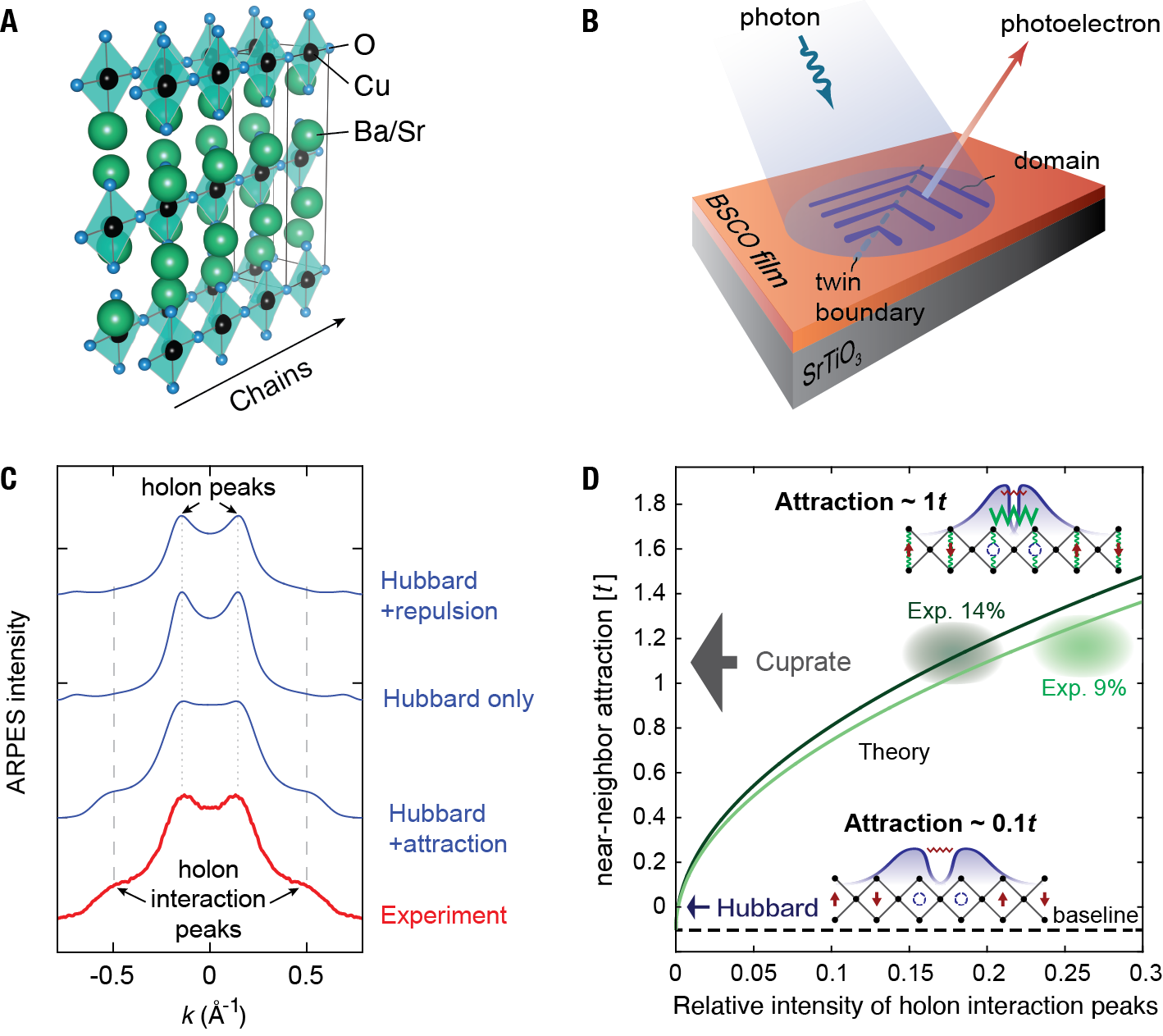
Figure: (A) Ba-Sr-Cu-O cuprate chain crystal structure, the doping concentration is controlled by the oxygen content. (B) Schematic diagram of the ARPES experiment. (C) An example of a theoretical-experimental comparison of the ARPES momentum distribution curve, showing that the strength of the characteristic peaks of the holon interaction is a key experimental measure of the near-neighbor attraction between electrons. (D) Theoretically, there is a one-to-one relationship between the intensity of the characteristic peaks of the holon interaction and the strength of the system's electron near-neighbor attraction. [Science 2021]
Is it possible that the electron-phonon coupling could lead to such strong attraction? It is generally believed that the electro-phonon coupling will decay rapidly with distance, so it is only necessary to consider the coupling effect in the same unit cell. However, in the curpate strong correlation system, the repulsion between electrons already exists at the same site, so the influence caused by the distant unit cell should probably be considered. Using state-of-the-art numerical methods, it was found that long-range phonon-mediated attractive interactions are in good agreement with experimental results [PRL 2021].

Figure: The relationship between the attraction interaction strength V and the action distance r. The electron-phonon coupling models with different coupling strengths (g = 40 meV – 200 meV), different coupling distances (From the HHM model with intra-cell interactions only, to the inclusion of all next-nearest neighbor couplings within a distance of 4 to the HHM), and different doping concentrations (12.5% and 25%) are considered. The results show that long-range electroacoustic coupling can significantly enhance V. [PRL 2021]
The electron-phonon coupling strength for cuprate HTS is strong, because the oxygen 2p orbitals are highly hybridized with copper 3d orbitals, where the superconducting electrons reside. Phonon modes corresponding to the vibration of the oxygen atoms provide attractive interactions between electrons. If we controllably weaken the hybridization of the oxygen 2p orbital, will TC decrease? By resonant photoemission spectroscopy, the energy density of states, the Hubbard Coulomb repulsion energy U and the charge transfer energy Delta were experimentally measured for the newly discovered nickelate superconductors. The results revealed that although the crystal structure and parent 3d9 electronic configuration of nickelate superconductors are identical to cuprates, the hybridization of oxygen 2p in nickelates is much weaker, and TC is also greatly reduced in nickelates [Matter 2022]. This correlation between the variation of oxygen 2p hybridization and TC suggests that phonons may indeed play an important role in superconducting pairing.
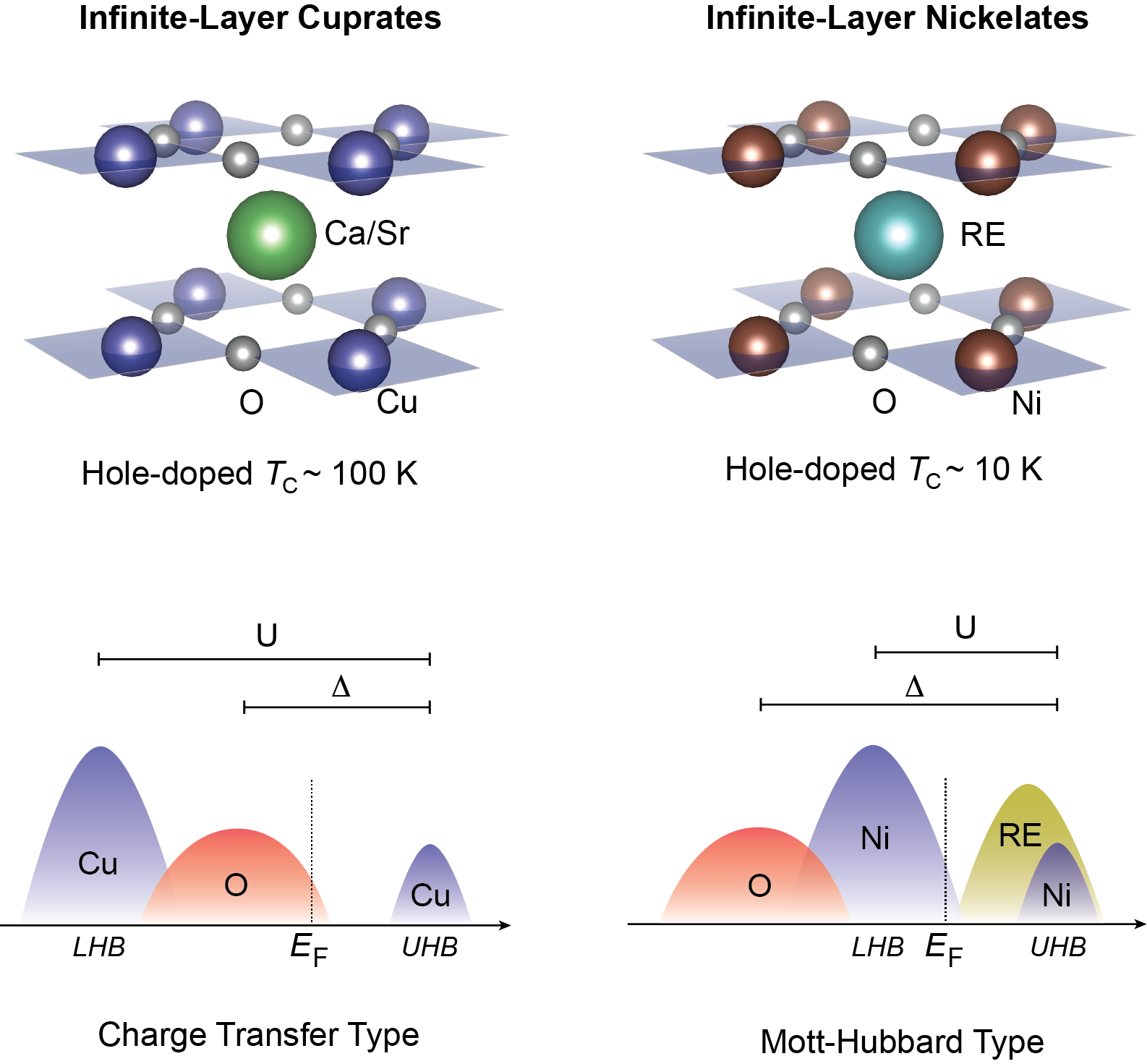
Figure: Comparison of the crystal structures and electronic structures of infinite-layer nickelate and cuprate superconductors: the oxygen 2p orbital of the nickelates is far below the Fermi energy, and the degree of hybridization is much lower than that of the cuprates. In addition, the rare earth element orbitals in the nickelates are close to the Fermi energy, which impact conductivity and even superconductivity. [Matter 2022]
Another widely influential HTS theory cocerns a putative quantum critical point (QCP) in the superconducting phase diagram, near which strong quantum fluctuations mediates attraction interactions between electrons and induces a dome shaped superconducting phase near the QCP. This critical point may be the boundary of the pseudogap (a phenomenon with an energy gap but no obvious coherence peak in the underdoped region), but it is still unclear exactly from what phase to what phase the quantum phase transition is. One major piece of evidence supporting the existence of the QCP is the peak in the specific heat near this point. In order to clarify the physical properties and influence of the QCP, in the wide hole doping range of 6% to 35%, systematic ARPES measurements of La2-xSrxCuO4 (LSCO) thin films are performed to obtain the 3D band structures and superconducting gap structures. There is a topological change of the Fermi surface (namely the Lifshitz transition) in LSCO near 21%. The Lifshitz transition naturally leads to a peak of density of states at the Fermi energy, and the peak of density of states calculated based on the band structure measured quantitatively matches the measured peak of the specific heat in previous experiments. This shows that theoretically it is unneccesary to introduce the QCP and the associated quantum fluctuations to explain the specific heat data. On the other hand, experiments also found that the d-wave symmetry and the size of the superconducting gap do not change substantially before and after the Lifshitz transition [PNAS 2022]. These results reveal that cuprate superconductivity, with d-wave symmetry and superconducting strength independent of the density of states at the Fermi energy, is indeed unconventional. On the other hand, it indicates that the relationship between the putative QCP and superconductivity needs to be further examined.
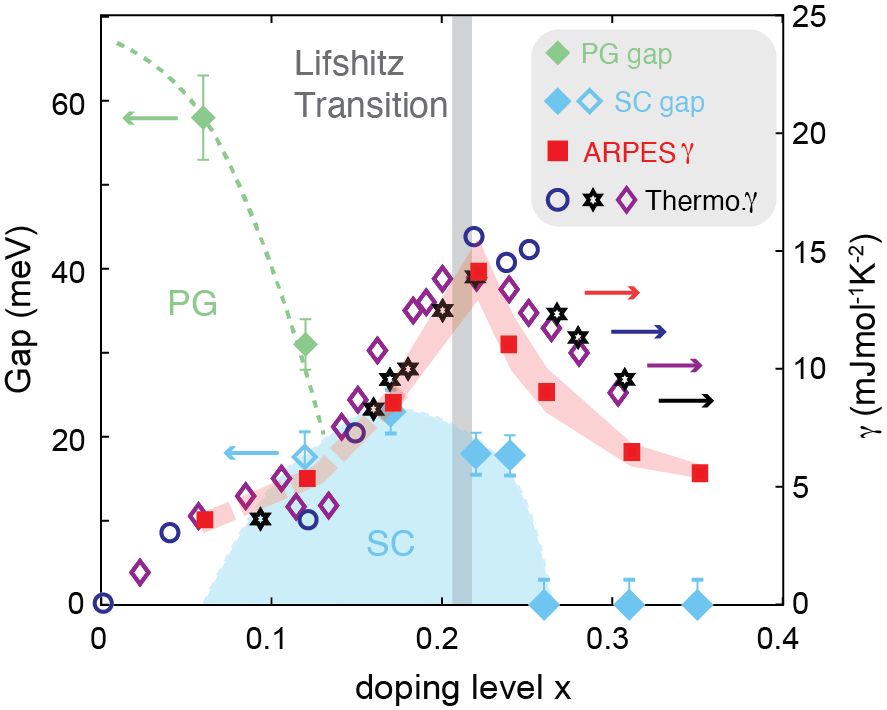
Figure: Dependence of energy gaps and specific heat on doping concentration in LSCO. [PNAS 2022]
02 Superconducting Phase Fluctuation
The superconducting phase fluctuation refers to a region where the Cooper pairs are formed, but they are not coherently condensed into a superfluid yet due to thermal and quantum fluctuations. This phenomenon is particularly prominent in 2D or quasi-2D systems. The study of superconducting phase transitions is not only of important for understanding the complex HTS phase diagrams, but also provides ideas for further increasing TC. The LaAlO3/SrTiO3 superconducting interface system was chosen as a prototype for studying this problem. Introducing a dual electrostatic gates structure in this 2D superconductor, continuous and independent control of carrier density and system disorder was achieved [Nano Lett. 2016]. Using quantum transport measurement at extremely low temperature and strong magnetic field, the superconducting multi-axis phase diagrams of this titanate interface is determined. The the source of the pseudogap and its relationship to origin of the 2D quantum Bose metal phase and the quantum fluctuations of the superconducting phase is studied [Nat. Commun. 2018]. In particular, the 2D Bose metal exhibits unique electromagnetic transport properties independent of time-reversal symmetry [npj Quant. Mater. 2021].
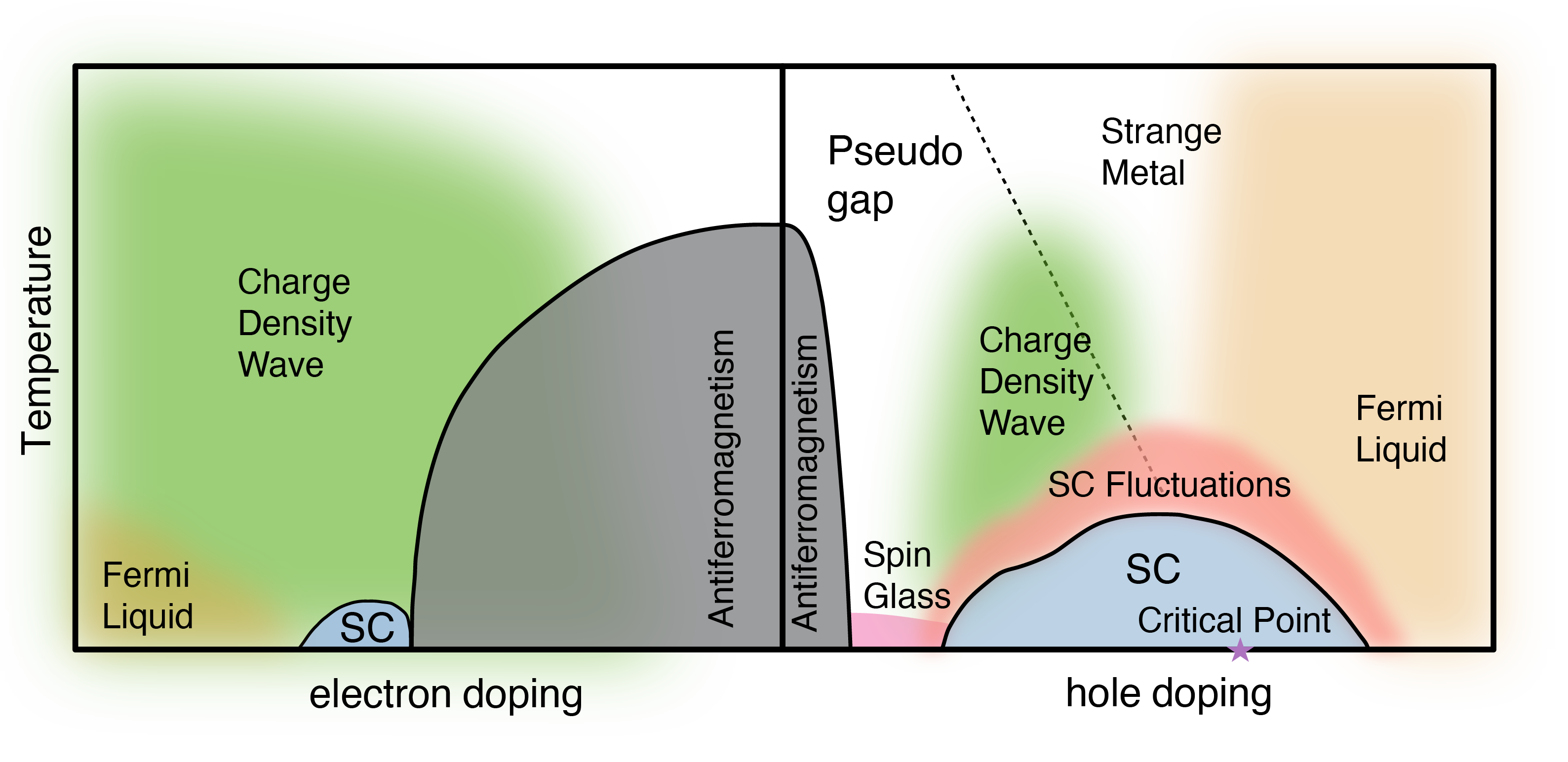
Figure: Cuprate HTS phase diagram. Large superconducting fluctuation regions are found in the hole-doped direction. The superconducting phase fluctuations in the electron-doped direction are still poorly understood.
Anderson's localization theory points out that in a weakly interacting 2D electronic system, there is no real metallic (finite-resistivity) state at zero temperature due to localization. However, in the experiments of 2D superconducting systems, it is often observed that there is a metal state approaching zero temperature near the superconducting phase. Whether there is a 2D quantum (zero-temperature) metal state has been controversial. In the 2D superconducting phase diagram of the gated LaAlO3/SrTiO3 interface, a pseudogap region appears on the negative side of gate voltage above the superconducting dome, which is highly similar to the cuprate phase diagram. Interestingly, a metallic state approaching zero temperature exists in this region. Clarifying the relationship between these pseudogap and the metallic state is crucial for understanding the superconducting-nonsuperconducting quantum phase transition in 2D systems.
Due to the structural inversion asymmetry, the top and back gates have different effects on the interfacial superconducting carrier distribution. The combination of dual gates can realize continuous and independent modulations of carrier density and disorder. The superconducting phase diagrams for top gate and back gate are apparently different. The phase diagrams can be divided into four regions, namely 2D superconductivity, Bose metal, vortex liquid and normal state. Among them, the Bose metal is the most exotic one: its has non-zero longitudinal resistance, but vanishing Hall resistance that is generally only seen in superconducting states. This indicates that the metal state has particle-antiparticle symmetry and that the dominating carriers are still Cooper pairs. In low-temperature magnetotransport, it is found that Bose metals exhibit linear magnetoresistance, and that the magnetoresistance derivative jump discontinuously at zero magnetic field, giving rise to a zero-field singularity. The peculiar transport phenomena of these Bose metals are consistent in both finite and zero magnetic fields, suggesting that these properties are independent of time-reversal symmetry.

Figure: Schematic diagram of the different effects of top-gate and back-gate modulations on carrier distribution (above) and interfacial superconducting phase diagrams (middle), where TC represents the global superconducting transition temperature, and TF represents the temperature at which phase fluctuations begin to dominate (Bose metal), and TP represents the temperature at which pairing is formed. (Below) Schematic diagram of four different states of matter in the superconducting phase diagrams, where S represents the superconducting state, N represents the normal state, and the small red arrows represent the superconducting phase. [Nat. Commun. 2018]
Tool Development
Condensed matter physics is a discipline concerned with the order of a large number of microscopic particles. Experimental physicists need to devote their efforts to two things: one is to create and prepare quantum materials of increasingly high quality, so that various quantum properties can be highlighted as much as possible without interference; the other is to continuously improve characterization techniques for various macroscopic and mesoscopic physical properties, as well as microscopic crystal and electronic structures, such that quantum properties can be measured more accurately, deeply, and comprehensively. In order to carry out research that was difficult to conduct before, it is necessary to develop more advanced experimental techniques.
Our efforts in the development of experimental tools have three aspects: one is to develop a more advanced thin film preparation system to access unprecedented thermodynamic and kinetic parameter space; the second is to develop in situ ARPES techniques compatible with thin films, as well as time-resolved ARPES to pursue higher time resolution; the third is to develop various quasi-in situ mesophysical testing tools compatible with thin films to ensure that thin films grown in ultra-high vacuum chambers do not need to be exposed to air for comprehensive electrical, magnetic, and thermal measurements.
01 Oxide Molecular Beam Epitaxy System
Molecular beam epitaxy (MBE) enables structural control of thin films with atomic-level precision and continues to contribute to experimental research in condensed matter physics. By controlling the opening and closing of the shutter for evaporation source MBE, or by using high-energy laser pulses to partially evaporate the target for laser MBE (also known as pulsed laser deposition, PLD), an atomic beam with precise stoichiometry will directly hit the temperature-adjustable substrate in an ultra-high vacuum (UHV) chamber. The atoms move to the appropriate sites and deposit to form an atomic layer that can support thin film growth on the substrate surface. The entire process of epitaxial growth is governed by thermodynamics and kinetics, and is monitored real-time by in situ reflection high-energy electron diffraction (RHEED).
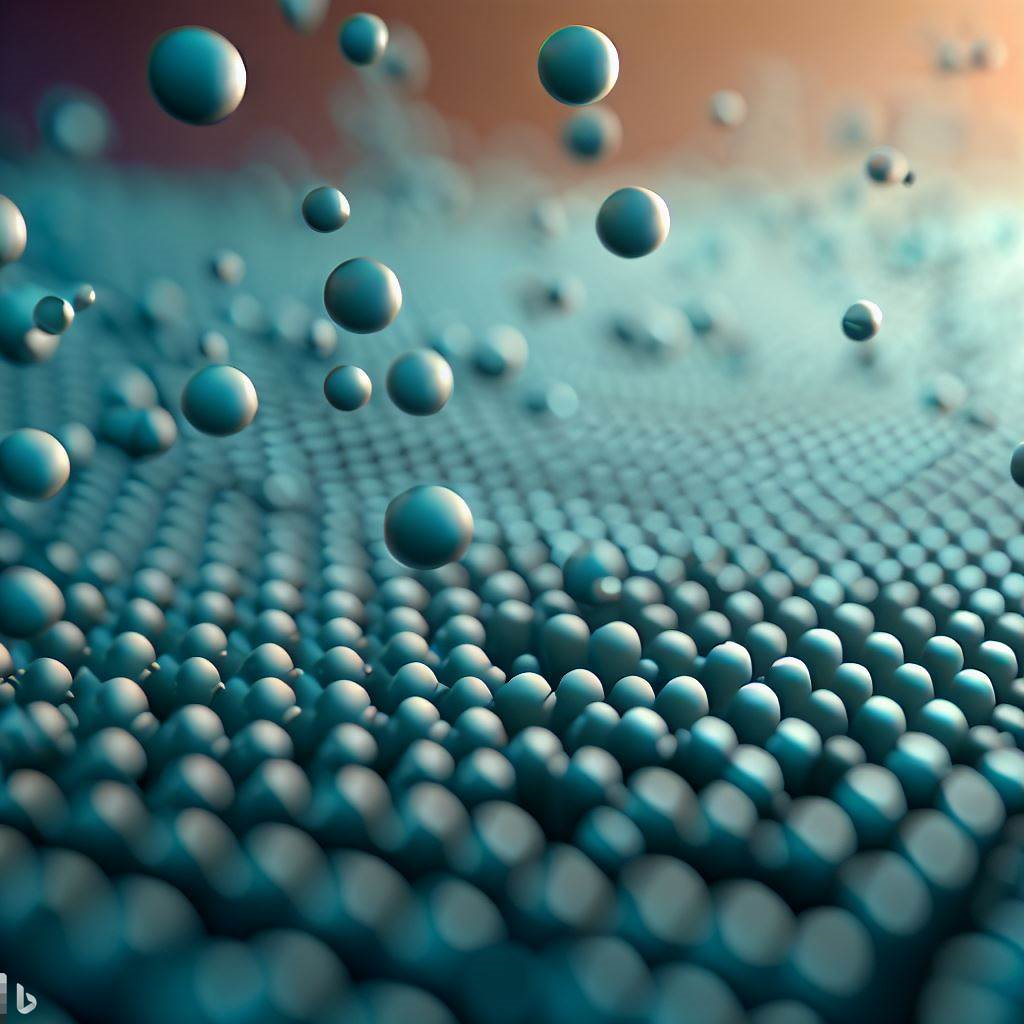
Figure: Schematic of thin film deposition (Source: Bing Image Creator)
Evaporation MBE and laser MBE have their advantages and disadvantages. For the evaporation type, since the temperature of each metal evaporation source can be individually and accurately adjusted, the accuracy of the stoichiometric ratio is very high, and the growth rate can be reduced to an extremely low level by adjusting the evaporation rate, which is beneficial to the precise control of growing a single layer or several layers of atoms. However, due to the different evaporation temperatures of various sources, for metals with lower evaporation temperatures, the kinetic energy of the deposited atoms may be low, and a higher substrate temperature is required to ensure that the deposited atoms get enough kinetic energy to move to the appropriate sites, while a high substrate temperature is not necessarily favorable for the thermodynamic stability of the desired crystalline phase. For laser MBE, due to the high energy of laser pulses, the target is excited in the form of plasma above 2000°C, so it has the characteristics of high kinetic energy. When the substrate temperature is low, the deposited atoms may still have enough kinetic energy to move to the appropriate sites, which is more conducive to the growth of crystal phases that are thermodynamically unstable at high temperatures, but since each pulse of the laser will stimulate a certain amount of atom evaporation, the control accuracy of the thickness of the extremely thin layer is slightly lower (up to about a few tenths of an atomic layer at best). Either way, thermodynamics and kinetics need to be considered jointly.
The two MBE systems both integrate evaporation and pulsed laser modes. They are equipped with liquefied and purified ozone, which is conducive to the growth of thin films that require a strong oxidizing environment. In addition to the oxidation chamber, one of the system is also equipped with a metal/atomic hydrogen reduction chamber, which can be used for in situ growth of metal films or reduction of oxide films. The specially designed high-purity ozone/atomic hydrogen functions will provide a strong oxidation/strong reduction environment for sample growth. In particualr, our designed oxidation strength is two orders of magnitude higher than that of conventional ozone systems. These self-designed systems have greatly expanded the thermodynamic and kinetic parameter space of our growth samples, giving us the opportunity to challenge thin films that have not been synthesized before.
We are also developing high-throughput combination thin-film preparation technique. Combining the pulsed laser deposition process with a motorized moving mask enables the growth of films with continuously varying compositions on the same substrate. This technique can not only shorten the time and improve efficiency, but also ensure the consistency of the experimental environment and help us conduct systematic research.
02 Angle-resolved photoelectron spectroscopy (ARPES)
Macroscopic physical phenomena exhibited by materials are originated from properties of microscopic electrons. The measurement of electronic structures with high precision is an indispensable step in understanding novel physical properties from microscopic level. Angle-resolved photoemission spectroscopy (ARPES) is a powerful tool that can directly probe the energy and momentum of electrons for energy band structures. It is an important means to study many-body interactions. ARPES utilizes the photoelectric effect: electrons on the surface of a material, excited by photons of a specific frequency, are called photoelectrons. The photoelectrons that escape at different angles are collected by the hemispherical analyzer. According to the conservation of energy and momentum, the state of motion of electrons inside the material can be determined by the measured kinetic energy and momentum (inferred from velocity angel) of photoelectrons.
Thin film samples grown in the UHV MBE chamber can be transferred to the ARPES chamber via a UHV suitcase. While ensuring that the samples in the whole process are in an UHV environment, the discrete MBE and ARPES systems without hard connections are more conducive to the expansion of their respective systems, such as the further development of time-resolved ARPES (trARPES). trARPES allows us to observe the dynamic changes of electronic structures on the femtosecond scale and capture the non-equilibrium quantum phenomena that are difficult to persist.
In the study of the mechanism of cuprate HTS, the contribution of electron-phonon coupling to superconducting pairing is an issue that needs to be clarified. For a long time, traditional static spectroscopy research on this issue has lacked key experimental evidence, let alone quantitative determination of the contribution of electron-phonon coupling to the formation of Cooper pairing. Ultrafast pump-probe technology can possibly detect this problem in the time domain. The laser pumping pulse can first induce superconducting carriers and related phonons to the excited state, and then the time delayed photon pulse or high-energy electron pulse can detect the evolution of electrons and lattice structure in the process of relaxation back to the ground state of the excited state. The correspondence between specific phonon modes and the formation of superconducting states might be able to be detected, enabling quantitative measurements of the electro-phonon coupling mechanism. However, this experiment is extremely challenging. The key reason is that the phonon frequency ~17 THz (i.e. the oscillation period ~60 fs) and the superconducting energy gap ~30 meV associated with cuprate superconductivity are highly demanding in terms of time resolution and energy resolution if they need to be observed simultaneously: this condition is close to the time-energy resolution limit determined by the uncertainty principle ΔE∙Δt ≥ 1825 meV∙fs. Therefore, choosing the appropriate pump-probe pulse type, parameters, and time-energy resolution combination is the key to realize the detection of high-frequency phonons in superconducting systems, which is the direction of our efforts.
03 Quantum state modulation and mesoscopic physical measurements
In the region of phase fluctuations where Cooper pairs have formed but are not yet globally coherent, the itinerant vortex and antivortex excitations undergo thermal diffusion due to temperature gradients, thus producing a significant Nernst effect. When the global superconductivity and the Meissner effect appear, the superfluid state of the Cooper pair is formed accordingly. In fact, in addition to the temperature at which the resistance becomes zero, the temperature at which the vortex liquid appears and the temperature at which the superfluid density appears are both key mesoscopic experimental physical quantities that reflect the states of the system.
For the research on the HTS mechanism, based on the commercial low-temperature strong magnetic field system (equipped with dilution refrigeration probes, AC magnetic susceptibility probes and horizontal rotating rods, etc.), we have further designed Nernst effect, magnetic mutual induction and point contact tunnel spectrum probes. We will also combine with an inert gas glove box to obtain the ability of sample packaging and transfer, such that electrical transport, Hall effect, Nernst effect, magnetic mutual inductance, and point contact tunneling can be performed quasi-in situ without contact with the atmospheric environment.
We are also working on innovations in quantum state modulation techniques. For example, freestanding flexible yttrium barium copper oxide (YBCO) HTS films can be synthesized, whose flexibility provides a unique experimental method for controlling the properties of HTS by using ultra-large strains [PR Mater. 2019]. Ionic liquid gates are also used to tune the spin-orbit coupling, dual-carrier properties, and quantum well states of quantum materials [Nano Lett. 2012, Appl. Phys. Lett. 2013, Nano Lett. 2016].
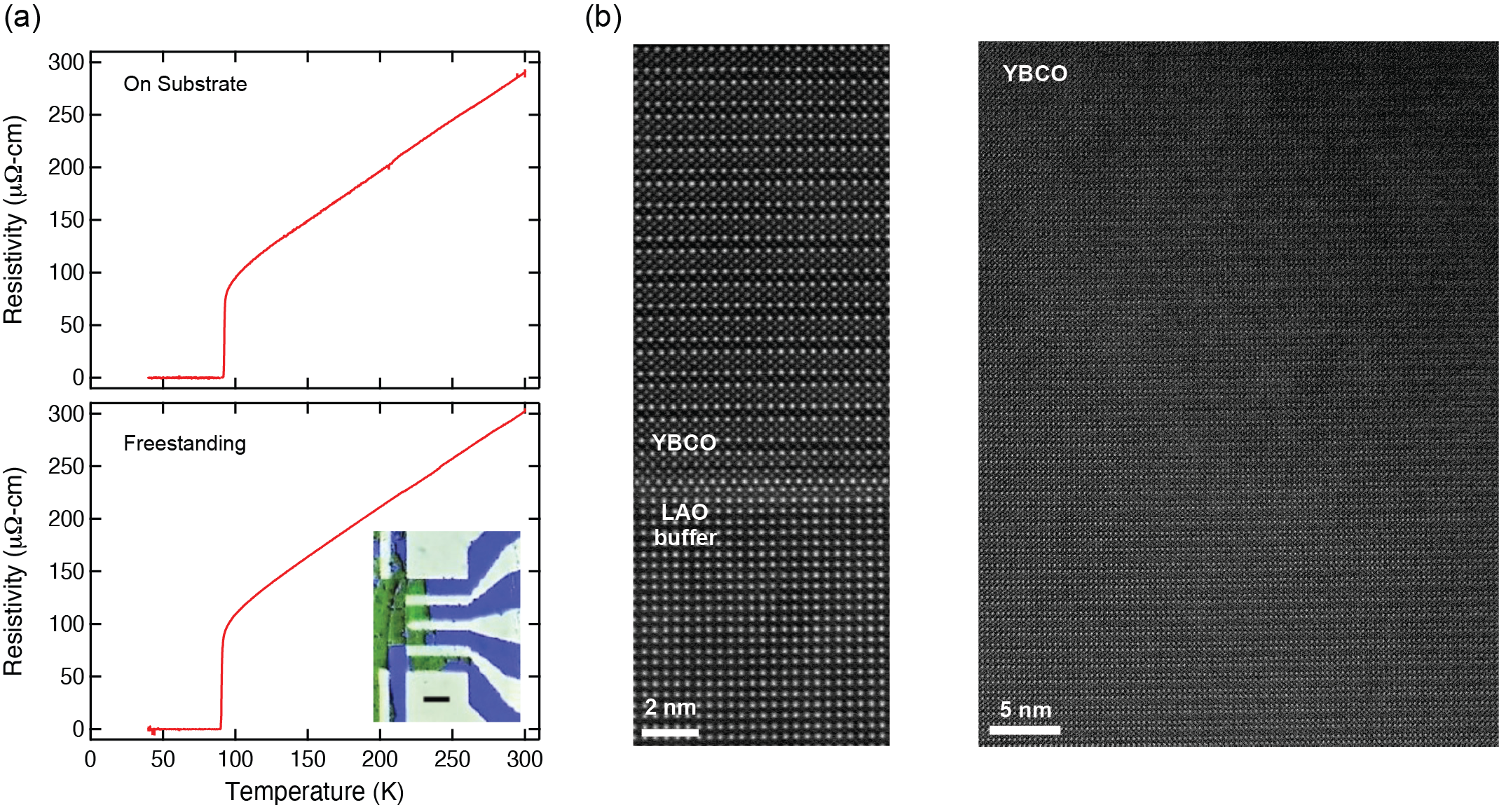
Figure: (A) Resistivity-temperature curves of YBCO films on and off the substrate (freestanding). (B) Scanning transmission electron microscopy images of the freestanding YBCO films with LaAlO3 buffer and cap layers. [PR Mater. 2019]
In addition, the laboratory is also equipped with an X-ray diffractometer (XRD) with ultra-high intensity (9kW) and resolution, a room-temperature atomic force microscope/scanning tunneling microscope (AFM/STM) with atomic resolution capabilities, etc.

